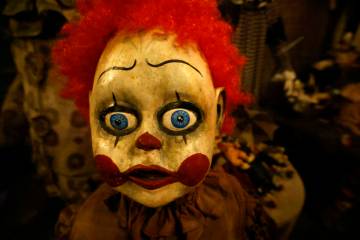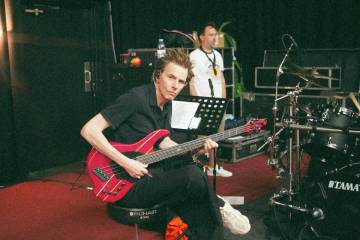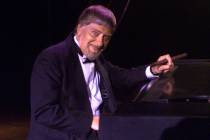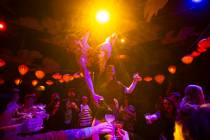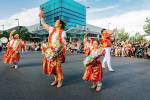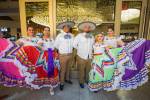Cirque performer adds another dimension to learning
The geology lesson is about to begin.
Rather than offering a lecture on the origin of igneous rocks, however, Benedikt Negro presents a dance piece with the apt title “The Igneous Rock.”
But not before asking the members of Richard Savage’s third-grade class at McCall Elementary School in North Las Vegas what they think an igneous rock might be.
“I think a-ginnis rock is a type of rock that’s still, but a little shaky,” one volunteers.
“I like your answer,” Negro replies in his soft German accent. “It’s very creative.” Alas, it’s wrong.
“A rock that looks like an egg?” another student asks.
“Igneous has to do with fire,” Negro explains, after which class members respond with a collective gasp.
“A fire rock?” one suggests.
Precisely.
After another student explains that lava is “the hot stuff that comes from a volcano,” Negro cranks up the volume on his smartphone to provide mood music (the lilting “Love Is Blue”) and goes into his dance.
Donning a poufy white shirt that billows like a cloud — a traditional Pierrot clown costume that reminds one student of an angel — the lanky Negro towers over the third-graders, who watch his every move with rapt attention.
He prances gracefully over to a table, where he picks up a red scarf (representing about-to-flow lava from the about-to-blow volcano) and proceeds to pantomime an eruption.
The dance climaxes with a magic trick in which Negro transforms the red scarf — presto change-o! — into a spongy red-and-yellow ball representing an igneous rock.
“Wow! Cool!” class members cheer as the performer bows to their eager applause.
For an encore, Negro demonstrates the secret behind the trick, so every kid in class can try it at home.
Chances are, every kid will.
When Negro queries the students — “Did you learn something new from the circus?” — 8-year-old Lissania Sotelo has a ready answer.
“If you keep on practicing every day,” she says, “you’ll get better and better.”
In other words, do your homework — but have fun in the process.
That’s the inspiration for Negro’s presence in Room 13. His weekly visits are part of Arts Nomades, a partnership between Cirque du Soleil and the Public Education Foundation that brings Cirque performers into classrooms to give a creative spin to academics.
After 10 years in Cirque’s home base of Montreal — where 30 teachers have worked with 6,000 students at eight schools — the program launched in Southern Nevada this academic year. Three teaching artists (specializing in circus, dance and visual arts) are working with third-graders at McCall and Gilbert elementary schools, both in North Las Vegas.
Las Vegas’ Arts Nomades program was in the planning stages for about two years prior to this year’s pilot program, according to Anik Couture, Cirque’s head of community relations.
After 10 years in Montreal, “we know it works,” she says. “We know it’s going to work here.”
Arts Nomades caters more to different kinds of learning, Couture explains. “We want it to be fun. It can still be frivolous, but it’s serious business.”
That’s how Negro — who’s performed as a mime in Bellagio’s “O” for 13 years — approaches his goal of “teaching kids academics and science and art.”
Before he was chosen as an Arts Nomades teacher, Negro participated in another Cirque program, conveying “life skills” by working with local kids “in critical situations” such as homeless shelters and youth camps.
Teaching in Arts Nomades is “quite a challenge,” he acknowledges, because the activities he conjures must entertain and address concepts students are studying.
The afternoon’s igneous rock dance, for example, was inspired by the class’ recent field trip to The Smith Center, where they watched Nevada Ballet Theatre’s production of “The Sleeping Beauty.”
In a previous lesson, “Mr. Benedikt” (as the kids all call him) introduced Professor Ellington, a character he invented to help explain the laws of physics. With a little help from a soccer ball, the good professor demonstrated such concepts as force and gravity.
Professor Ellington’s name resurfaces during this week’s class, but “he’s back in Cambridge, in his university,” Negro tells the students. “He promised to come back.”
Not that his charges seem too concerned.
They’re too busy practicing how to flip brightly colored “devil sticks” with shorter hand sticks, one in each hand. (In the process, they’re exploring gyroscopic juggling — or, to use the circus term, equilibristics.)
“Watch me! Watch me!” Negro chants as the students surround him in a half-circle to await his instruction.
“Watch you! Watch you!” the kids reply before they erupt in motion, trying to replicate his deft devil sticks skills.
“Oh, you had a beautiful throw,” he says after 8-year-old Daniel Solis shows him the trick. “But you’re catching it too early. Relax.”
Another student calls, “Mr. Benedikt! Look! I can do it!”
As kids demonstrate their expertise, one by one, their classmates respond by pounding their hand sticks on the devil’s sticks, creating an enthusiastic racket.
It may look like sheer fun, but teacher Richard Savage acknowledges the learning involved as well.
“I love it,” he says of the Arts Nomades program. “Both of the Arts Nomades teachers are super-personable” and ask what lessons he’d like them to reinforce.
“The kids only hear it from me one way,” Savage adds. Whether the exercises reinforce counting practices or number fluency — both related to the core curriculum — “it’s something they have fun doing.”
Read more stories from Carol Cling at reviewjournal.com. Contact her at ccling@reviewjournal.com and follow @CarolSCling on Twitter.




















